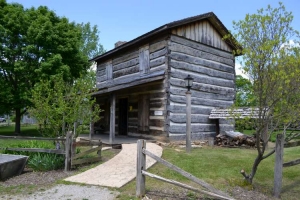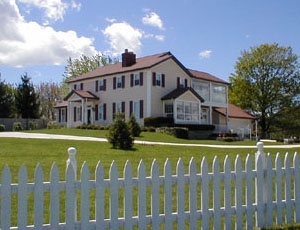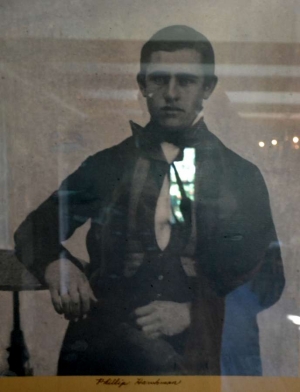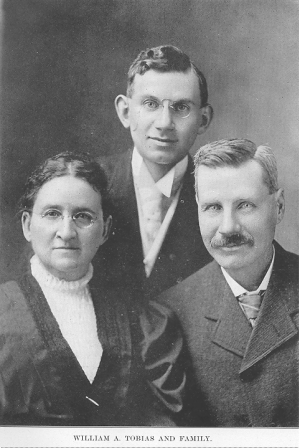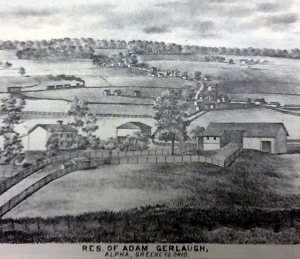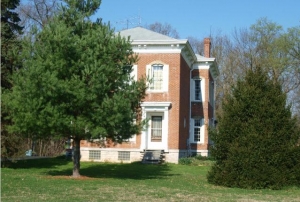Book
Displaying items by tag: House
This house was originally located on Ankeney Road on the property owned by Mary and Phil Ankeney. It was donated to the Beavercreek Historical Society by them and rebuilt at Wartinger Park in 1993. Samuel Ankeney, age 19, bought the Ankeney House in 1830 along with 210 acres after his father died in 1830, having just arrived from western Maryland. Samuel built a kitchen for his mother and added it onto the house. He was the oldest of ten children.
The cabin was about four years old when Samuel Ankeney bought it from John Davis. The Ankeney House fireplace was rebuilt in 1997 with bricks from the old Beavercreek High School which had burned in 1996.
 Ankeney House Kitchen 1
Ankeney House Kitchen 1
Ankeney House Kitchen 1
Ankeney House Kitchen 1
 Ankeney House Kitchen 2
Ankeney House Kitchen 2
Ankeney House Kitchen 2
Ankeney House Kitchen 2
 Ankeney House Living Room 1
Ankeney House Living Room 1
Ankeney House Living Room 1
Ankeney House Living Room 1
 Ankeney House Living Room 2
Ankeney House Living Room 2
Ankeney House Living Room 2
Ankeney House Living Room 2
 Ankeney House Kitchen 3
Ankeney House Kitchen 3
Ankeney House Kitchen 3
Ankeney House Kitchen 3
 Ankeney House Kitchen 4
Ankeney House Kitchen 4
Ankeney House Kitchen 4
Ankeney House Kitchen 4
 Ankeney House Plumbing
Ankeney House Plumbing
Ankeney House Plumbing
Ankeney House Plumbing
 The Early Oven/Stove
The Early Oven/Stove
The Early Oven/Stove
The Early Oven/Stove
https://www.beavercreekliving.com/book/itemlist/tag/House#sigProId69858c2753
The Philip Harshman house (c. 1803-1807) was discovered in 1985 when a wood-sided two-story house, which was originally located just south of St. Luke Catholic Church on North Fairfield Road, was condemned and slated for demolition. When the wood siding was removed, the original log house was revealed. An effort was quickly begun by a group of local citizens, that later became the Beavercreek Historical Society, to save the historic structure for restoration. The stone pathways to the Harshman House kitchen garden as well as those leading to the Ankeney House are limestone rocks which were saved from the foundation of the old Lantz Barn on Kemp Road.
https://www.beavercreekliving.com/book/itemlist/tag/House#sigProId4fecc2fc5e
Turn east on Lakeview Drive and follow around to the right.
Perched on a hill at 2381 Old Home Court is the stately Tobias–Zimmer House, built in 1859 by Peter Tobias. The land was originally deeded to Jesse Hunt via a land grant and subsequently divided. It was so densely wooded that it became known as “The Big Woods”. An early schoolhouse was built in 1839 on a half acre of land donated by then owner, Henry Ankeney. The limestone front step and school bell can still be seen in the front yard! The Shaker construction features hand hewn, mortised and pinned white oak frame construction with walnut woodwork.
In 1950, Bob Zimmer purchased the 103 acre farm from the Batdorf family, which ran Miami Valley’s largest turkey farm onsite in the 1940’s.
In the vacant lot just south of the present St. Luke Church was a condemned wood-sided home, scheduled for demolition. When the siding was removed, the original log home was revealed. The home had been constructed between 1803 and 1807 by Phillip Harshman, a blacksmith who brought his bride, Frances “Fannie” Durnbaugh with him from Frederick County, Maryland. They lived in their covered wagon while the home was under construction. Phillip became a farmer and never returned to blacksmithing.
The saving and restoration of this home was conducted in 1985 by a group of citizens who later became the Beavercreek Historical Society.
Years later, and across the street, another log home was found...
https://www.beavercreekliving.com/book/itemlist/tag/House#sigProId4f44754d4b
A few blocks west on the north side of the road is the John Ferguson House at 2806 Dayton-Xenia Road, built in 1866. The home is of Italianate design, featuring a custom Ionic porch with custom millwork prevalent inside and out.
At the bottom of the hill, you’ll cross a stream know as Bull Skin Run which is spring fed from as far north as the Mall at Fairfield Commons. It ties into the Little Beaver Creek at the Creekside Trail Bikeway. Every pond, creek, stream and spring was integral to life and business during the settling of our community. On their banks you’ll find the concentrations of homes, mills, dairies, and farms.
The second 90° turn is home to the William Tobias House at 2057 Beaver Valley Road, built about 1820. Formerly known as Broadview Farm, this is located on an old Shawnee Indian trail. William Tobias had been a tenant farmer in Sugarcreek Township and purchased a log home and 86 acres in 1869. He replaced it with a two-story mortised and pinned frame structure prior to 1879.
The William Tobias House is now owned and maintained by local developer, Bob Mills.
At the first 90° curve sits the Gerlaugh-Tobias House built by David Gerlaugh in 1821. Built in the vernacular style with Shaker influences, the foundation walls are of brick and there is a full basement – very unusual for the era. The Siebenthaler Company bought it in 1979 and is preserving the historical integrity of the home.
An ancient Siberian Elm dominates the front yard. OSU has designated it the largest elm of its kind in the United States.
https://www.beavercreekliving.com/book/itemlist/tag/House#sigProId92c73b4189
On the south side of the road at 1643 Dayton-Xenia Road is the Morningstar-Hanes House. A beautiful Greek Revival brick, the original structure was constructed on 191 acres in 1830 by George Morningstar, a builder of many of the log cabins in Beavercreek in the early 1800’s. In 1849, new owner Adam Hanes, a prominent farmer, added the east brick section. Current owner, Robert Messmore added an identical brick section on the west end of the home and the center porch.
https://www.beavercreekliving.com/book/itemlist/tag/House#sigProIdbbd299d611
At 1035 Ankeney Road you’ll find the Albert Ankeney House. Built in 1872 by Albert Ankeney Sr., grandson of pioneer David Ankeney, it is of the Italianate style designed by renowned Dayton architect M. Borrow. The limestone came from the Archer quarry and all 66,000 bricks were fired onsite.
This is the grandest and best preserved of all the Beavercreek historic homes and retains its original charm and glory.
https://www.beavercreekliving.com/book/itemlist/tag/House#sigProId792b509b91
As you approach U.S. Route 35, prepare to head east on Heller Drive. Ahead of you was a lane that once traversed an orchard of over 300 fruit trees! The majestic Georgian Colonial home on the cul-de-sac across the highway, appropriately named Orchard Lane, was constructed by John Harbine for he and wife Hettie in 1832. Historical accounts conflict as to whether John and Hettie lived in the log cabin at its original location during the construction of the Harbine House. It might have been moved a short distance in 1825 to what eventually became the front yard of the new Harbine residence.
The home was in the Harbine family for 117 years. A self-contained establishment, they raised grain, livestock, fruit and vegetables; they milled the grain, dried, stored and canned fruits and vegetables, butchered beef and made soap. Their cattle provided milk and butter for the family. Linen was woven from flax fiber, all onsite!
In 1944, the Heller family purchased the home and remaining 75 acres with plans to extensively improve the homestead. A few years later, the State planned a new expressway; the design would cause the razing of the Heller home. A five-year legal battle ensued with the State finally agreeing to a curve in the U.S. Route 35 to save the home. The orchard and seclusion were destroyed. Several small tracts are still owned by the Heller family.
The home was purchased by the Children’s Services Board in 1988 as a group home. It was sold in 2015 at auction to the adjacent car dealer, sealing its fate. Another, higher bid had been received at the 11th hour that would have ensured survival of the Harbine-Heller home, but was rejected by the county commissioners. The home was bulldozed in 2017. We don't know if any of the artifacts were salvaged prior to razing.
 Harbine House Front
Harbine House Front
Harbine House Front
Harbine House Front
 Harbine House Handrail
Harbine House Handrail
Harbine House Handrail
Harbine House Handrail
 Harbine House Scrollwork
Harbine House Scrollwork
Harbine House Scrollwork
Harbine House Scrollwork
 Harbine House Doorknob
Harbine House Doorknob
Harbine House Doorknob
Harbine House Doorknob
 Harbine House Stair Landing
Harbine House Stair Landing
Harbine House Stair Landing
Harbine House Stair Landing
 Harbine House Threshold
Harbine House Threshold
Harbine House Threshold
Harbine House Threshold
 Harbine House Butler Pantry
Harbine House Butler Pantry
Harbine House Butler Pantry
Harbine House Butler Pantry
 Harbine House Cellar Fireplace
Harbine House Cellar Fireplace
Harbine House Cellar Fireplace
Harbine House Cellar Fireplace
 Harbine House Cellar Doorway
Harbine House Cellar Doorway
Harbine House Cellar Doorway
Harbine House Cellar Doorway
 Harbine House Cellar Door Latch
Harbine House Cellar Door Latch
Harbine House Cellar Door Latch
Harbine House Cellar Door Latch
 Harbine House Third Level Mezzanine
Harbine House Third Level Mezzanine
Harbine House Third Level Mezzanine
Harbine House Third Level Mezzanine
 Harbine House Close
Harbine House Close
Harbine House Close
Harbine House Close
 Harbine House Plaster On Lath
Harbine House Plaster On Lath
Harbine House Plaster On Lath
Harbine House Plaster On Lath
 Harbine House NW Attic
Harbine House NW Attic
Harbine House NW Attic
Harbine House NW Attic
 Harbine House SW Attic
Harbine House SW Attic
Harbine House SW Attic
Harbine House SW Attic
 Harbine House Plaster On Lath 2
Harbine House Plaster On Lath 2
Harbine House Plaster On Lath 2
Harbine House Plaster On Lath 2
 Harbine House Trap Door
Harbine House Trap Door
Harbine House Trap Door
Harbine House Trap Door
 Harbine House Group Home Bedroom
Harbine House Group Home Bedroom
Harbine House Group Home Bedroom
Harbine House Group Home Bedroom
 Harbine House Porch
Harbine House Porch
Harbine House Porch
Harbine House Porch
 Harbine House Parlor Marble Fireplace 1
Harbine House Parlor Marble Fireplace 1
Harbine House Parlor Marble Fireplace 1
Harbine House Parlor Marble Fireplace 1
 Harbine House Parlor Marble Fireplace 2
Harbine House Parlor Marble Fireplace 2
Harbine House Parlor Marble Fireplace 2
Harbine House Parlor Marble Fireplace 2
 Harbine House Iron Register
Harbine House Iron Register
Harbine House Iron Register
Harbine House Iron Register
 Harbine House Steam Heat Radiator
Harbine House Steam Heat Radiator
Harbine House Steam Heat Radiator
Harbine House Steam Heat Radiator
 Harbine House Parlor Crown Mould
Harbine House Parlor Crown Mould
Harbine House Parlor Crown Mould
Harbine House Parlor Crown Mould
 Harbine House Parlor View
Harbine House Parlor View
Harbine House Parlor View
Harbine House Parlor View
 Harbine House Ceiling Medallion
Harbine House Ceiling Medallion
Harbine House Ceiling Medallion
Harbine House Ceiling Medallion
 Harbine House Central Staircase
Harbine House Central Staircase
Harbine House Central Staircase
Harbine House Central Staircase
 Harbine House Dining Room
Harbine House Dining Room
Harbine House Dining Room
Harbine House Dining Room
 Harbine House Dining Fireplace
Harbine House Dining Fireplace
Harbine House Dining Fireplace
Harbine House Dining Fireplace
 Harbine House Stair Paneling
Harbine House Stair Paneling
Harbine House Stair Paneling
Harbine House Stair Paneling
 County Commissioner Minutes
County Commissioner Minutes
County Commissioner Minutes
County Commissioner Minutes
https://www.beavercreekliving.com/book/itemlist/tag/House#sigProId169d18b4d4
Behind Beaver Cemetery sits the Jacob Coy House, now owned by Beavercreek Township. Five generations of Coy’s occupied the two-story log home built by Jacob in 1824. It originally sat at 3279 Shakertown Road in the middle of 3,000 acres Jacob had purchased in 1801.
Mainly through the efforts of Roger Coy, his great-great grandfather’s home was moved intact, on July 6, 1989 to its present location in Phillips Park. Protective siding has been installed and the basement of the structure has been modernized and is leased as the offices for the Beavercreek Wetlands Association. The main level was leased by the Beavercreek Historical Society until 2016 when they moved across the road to the former Beavercreek Township office building.
Please exit the parking lot to the right, returning west on Dayton-Xenia Road.
Navigation
Latest Blog Posts
- Just Don't Call Us Late For Dinner...
- Remember When...
- What A Long, Strange Trip It's Been...
- Snow Down = Slow Down
- School Bus Safety - Just Do It!
- Stevenson Road Covered Bridge
- Our Road Crews Are Worth Their Salt!
- The Most Colorful Of Seasons!
- Popcorn Fest! - Then And Now
- Pre-School Paradise!
- Remembering Riffles
- Ten Year Anniversary Of The Beaver Statues


